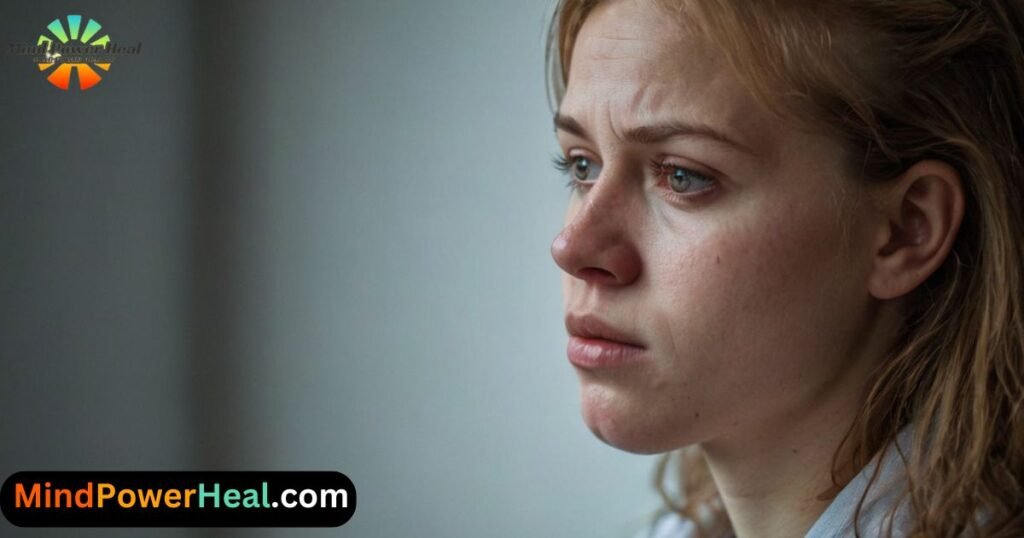Depression Symptoms According to DSM 5 is the major and crucial element for The Diagnostic and Statistical Manual of Mental Disorders, Fifth Edition (DSM-5) outlines specific criteria for diagnosing Major Depressive Disorder (MDD). Understanding these symptoms in detail is essential for accurate diagnosis and treatment. Additionally, integrating mind power healing can offer complementary strategies for managing depression.

Depression Symptoms According to DSM 5 Criteria
To diagnose MDD, at least five of the following symptoms must be present during the same 2-week period, representing a change from previous functioning; at least one of the symptoms should be either (1) depressed mood or (2) loss of interest or pleasure.
Depressed Mood:
Most of the day, nearly every day, as indicated by subjective report or observation made by others. For example, feeling sad, empty, hopeless, or appearing tearful.
- Example: Jane feels persistently sad and tearful without any apparent reason, making it difficult for her to engage in her daily activities.
Markedly Diminished Interest or Pleasure:
In all, or almost all, activities most of the day, nearly every day.
- Example: John, who used to enjoy gardening, no longer finds any joy in it and stops participating altogether.
Significant Weight Loss or Gain:
A change of more than 5% of body weight in a month, or a decrease or increase in appetite nearly every day.
- Example: Sarah notices she has lost 10 pounds in a month without trying, due to a lack of appetite.
Insomnia or Hypersomnia:
Nearly every day.
- Example: Mark finds it hard to fall asleep and stay asleep at night, waking up multiple times, and feeling fatigued throughout the day.

Psychomotor Agitation or Retardation:
Nearly every day; observable by others, not merely subjective feelings of restlessness or being slowed down.
- Example: Emily’s movements have become noticeably slower, and she struggles with tasks that require motor coordination.
Fatigue or Loss of Energy:
Depression Symptoms According to DSM 5 fatigue or loss of energy Nearly every day.
- Example: Tom feels exhausted after minor tasks and spends most of his day in bed due to a lack of energy.
Feelings of Worthlessness or Excessive or Inappropriate Guilt:
Depression Symptoms According to DSM 5 feelings of worthlessness or excessive or inappropriate guilt Nearly every day.
- Example: Lisa constantly feels worthless and blames herself for things beyond her control, believing she is a burden to her family.
Diminished Ability to Think or Concentrate, or Indecisiveness:
Depression Symptoms According to DSM 5 diminished ability to think Nearly every day.
- Example: Kevin finds it difficult to concentrate on his work and makes frequent mistakes, feeling overwhelmed by simple decisions.
Recurrent Thoughts of Death, Suicidal Ideation, or Suicide Attempt:
Depression Symptoms According to DSM 5 recurrent thoughts of death Not just fear of dying.
- Example: Rachel frequently thinks about death and has considered suicide, feeling that life is not worth living.

Integrating Mind Power Healing
Mind power healing focuses on harnessing the power of the mind to influence physical and emotional well-being. Techniques such as meditation, positive affirmations, and visualization can be integrated to support individuals with MDD.
Techniques and Examples
Meditation and Mindfulness:
Practicing mindfulness can help reduce symptoms by focusing on the present moment and reducing negative thought patterns.
- Example: Lisa practices mindfulness meditation daily, which helps her manage feelings of worthlessness and brings a sense of peace and acceptance.
Positive Affirmations:
Repeating positive affirmations can help rewire negative thought patterns and promote a positive self-image.
- Example: Kevin uses affirmations such as “I am capable and strong” to combat his feelings of indecisiveness and improve his concentration.

Visualization:
Visualizing positive outcomes and scenarios can help shift focus from negative to positive thoughts.
- Example: Sarah visualizes herself enjoying her meals and feeling healthy, which helps improve her appetite and overall mood.
Table: DSM-5 Depression Symptoms and Mind Power Healing Techniques
| Symptom | Description | Mind Power Healing Technique | Example |
|---|---|---|---|
| Depressed Mood | Persistent sadness, emptiness, hopelessness | Meditation, Positive Affirmations | Lisa practices daily meditation to manage her feelings of worthlessness. |
| Diminished Interest or Pleasure | Loss of interest in activities once enjoyed | Visualization | John visualizes himself enjoying gardening again to rekindle his interest. |
| Significant Weight Loss or Gain | Unintentional weight change or appetite alteration | Mindful Eating, Visualization | Sarah practices mindful eating to reconnect with her appetite. |
| Insomnia or Hypersomnia | Difficulty sleeping or sleeping excessively | Sleep Hygiene, Meditation | Mark follows a sleep routine and meditates before bed. |
| Psychomotor Agitation or Retardation | Noticeable restlessness or slowed movements | Gentle Yoga, Meditation | Emily practices gentle yoga to improve her motor coordination. |
| Fatigue or Loss of Energy | Persistent tiredness | Energy Visualization, Affirmations | Tom uses energy-boosting affirmations to combat his fatigue. |
| Feelings of Worthlessness or Guilt | Inappropriate guilt, feeling of worthlessness | Positive Affirmations, Cognitive Reframing | Lisa uses affirmations to challenge her negative self-perceptions. |
| Diminished Ability to Think or Concentrate | Difficulty in concentrating or decision-making | Mindfulness, Brain Training Exercises | Kevin practices brain training exercises to improve his concentration. |
| Recurrent Thoughts of Death or Suicide | Suicidal ideation or thoughts of death | Crisis Intervention, Therapy Support | Rachel seeks therapy and uses mindfulness to manage her thoughts. |
Conclusion
Understanding the Depression Symptoms According to DSM 5 criteria for Major Depressive Disorder is crucial for accurate diagnosis and treatment. Integrating mind power healing techniques can provide additional support for managing symptoms and promoting overall well-being. This holistic approach helps individuals harness the power of their minds to facilitate healing and improve their quality of life.

Google Suggested Questions Depression Symptoms According to DSM 5
What are the major symptoms of depression according to DSM-5?
The DSM-5 outlines several symptoms for Major Depressive Disorder, including depressed mood, loss of interest or pleasure, significant weight change, sleep disturbances, psychomotor changes, fatigue, feelings of worthlessness or guilt, difficulty concentrating, and recurrent thoughts of death or suicide. To be diagnosed, at least five of these symptoms must be present for a minimum of two weeks, with at least one being either depressed mood or loss of interest or pleasure.
2. How is Major Depressive Disorder diagnosed?
MDD is diagnosed through a clinical evaluation by a mental health professional. The professional will assess the presence of DSM-5 symptoms, their duration, and the impact on the individual’s daily functioning. Additional assessments and screenings may be used to rule out other conditions.
3. Can mind power healing help with depression?
Yes, mind power healing can be a helpful complementary approach for managing depression. Techniques such as meditation, mindfulness, positive affirmations, and visualization can help individuals manage symptoms by promoting relaxation, reducing negative thought patterns, and enhancing overall well-being.
4. What is the role of mindfulness in treating depression?

Mindfulness involves focusing on the present moment without judgment. It helps reduce stress, improve mood, and decrease symptoms of depression by encouraging individuals to be aware of their thoughts and feelings without becoming overwhelmed by them. Regular mindfulness practice can lead to improved emotional regulation and a greater sense of peace.
5. How can positive affirmations improve mental health in depression?
Positive affirmations help to counteract negative thought patterns that are common in depression. By regularly repeating positive statements about oneself, individuals can gradually shift their mindset towards a more positive and self-affirming outlook. This can improve self-esteem and reduce feelings of worthlessness.
6. What is the difference between major depressive disorder and persistent depressive disorder?
Major Depressive Disorder (MDD) involves severe depressive episodes that last for at least two weeks, whereas Persistent Depressive Disorder (PDD), also known as dysthymia, is a chronic form of depression with less severe symptoms that last for at least two years. Individuals with PDD may experience longer periods of mild depression with occasional episodes of major depression.
7. Are there any lifestyle changes that can help manage depression?
Yes, several lifestyle changes can help manage depression. These include regular physical activity, maintaining a healthy diet, getting adequate sleep, practicing stress-reduction techniques like yoga or meditation, and engaging in social activities. These changes can improve overall well-being and help reduce depressive symptoms.
8. How does visualization work in mind power healing for depression?
Visualization involves creating positive mental images to influence one’s emotional state. For depression, visualization can help individuals focus on positive scenarios, such as achieving personal goals or experiencing joy in daily activities. This practice can help shift attention away from negative thoughts and foster a more hopeful and optimistic mindset.



